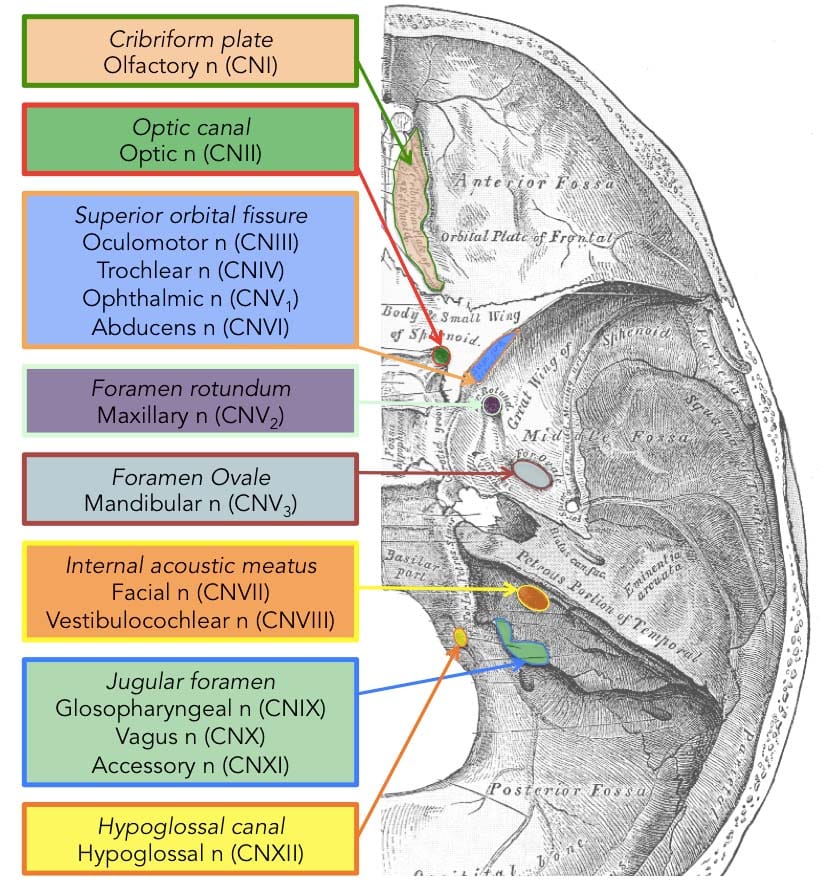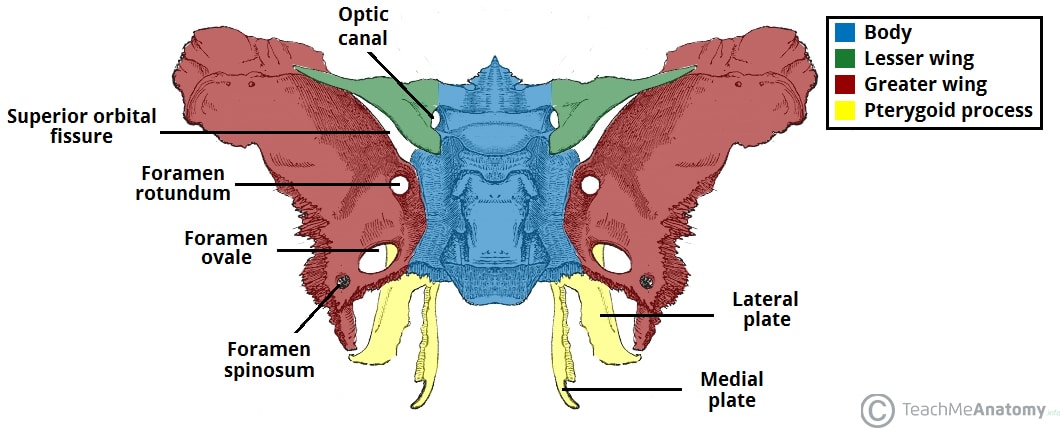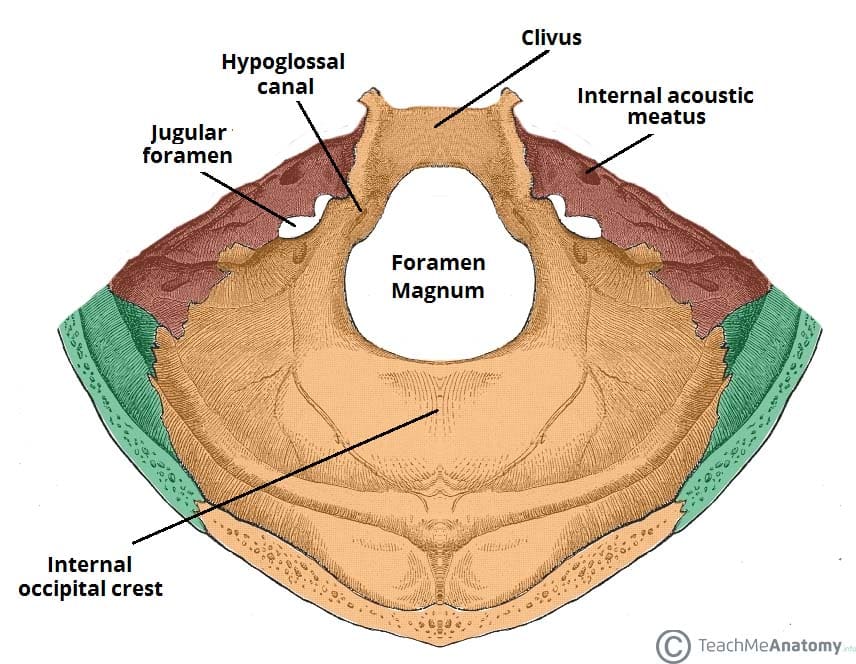A foramen (pl. foramina) is an opening that allows the passage of structures from one region to another.
In the skull base, there are numerous foramina that transmit cranial nerves, blood vessels and other structures – these are collectively referred to as the cranial foramina.
In this article, we shall look at some of the major cranial foramina, and the structures that pass through them.
Cranial Nerve Foramina
The foramina of the skull are most commonly considered in the context of the cranial nerves. In this section, we will discuss the foramina that transmit cranial nerves.

Figure 1 – Superior view of the skull base showing the foramina and which cranial nerves pass through them.
Cribriform Foramina
The cribriform foramina refer to numerous perforations in the cribriform plate of the ethmoid bone. They connect the anterior cranial fossa with the nasal cavity.
These foramina allow the passage of axons of the olfactory nerve from the olfactory epithelium of the nose into the anterior cranial fossa where they communicate with the olfactory bulb.
Optic Canal and Foramen
The optic canal permits the passage of the optic nerve (CN II) and the ophthalmic artery into the bony orbit.
It is bounded medially by the body of the sphenoid, and laterally by the lesser wing of the sphenoid bone
Superior Orbital Fissure
The superior orbital fissure is a cleft that opens anteriorly into the orbit, and enables communication between the cavernous sinus and the apex of the orbit
It is bordered superiorly by the lesser wing and inferiorly by the greater wing of the sphenoid bone.
It transmits several structures that are listed below (from superior to inferior):
- Lacrimal nerve (branch of the ophthalmic nerve, the first division of the trigeminal nerve)
- Frontal nerve (branch of the ophthalmic nerve, the first division of the trigeminal nerve)
- Superior ophthalmic vein
- Trochlear nerve (CN IV)
- Superior division of the Oculomotor nerve (CN III)
- Nasociliary nerve (branch of the ophthalmic nerve, the first division of the trigeminal nerve)
- Inferior division of the Oculomotor nerve (CN III)
- Abducens nerve (CN VI)
- A branch of the Inferior ophthalmic vein

Fig 2 – Foramina and bony landmarks of the sphenoid wings and pterygoid process.
Foramen Rotundum
The foramen rotundum is located at the base of the greater wing of the sphenoid, inferior to the superior orbital fissure.
It provides a connection between the middle cranial fossa and the pterygopalatine fossa. The maxillary nerve (branch of the trigeminal nerve, CN V) passes through this foramen.
Foramen Ovale
The foramen ovale is another opening located at the base of the greater wing of the sphenoid.
It is positioned posterolateral to the foramen rotundum within the middle cranial fossa. It conducts the mandibular nerve (branch of the trigeminal nerve, CN V) and the accessory meningeal artery.
Internal Acoustic Meatus
The internal acoustic meatus is a bony passage located within the petrous part of the temporal bone.
The canal connects the posterior cranial fossa and the inner ear, transporting neurovascular structures to the auditory and vestibular apparatus. The facial and vestibulocochlear nerves pass through the internal acoustic meatus, alongside the vestibular ganglion and labyrinthine artery.
Jugular Foramen
The jugular foramen is formed anteriorly by the petrous part of the temporal bone and posteriorly by the occipital bone.
It can be considered as three separate compartments with their respective contents:
- Anterior – contains the inferior petrosal sinus (a dural venous sinus).
- Middle – transmits the glossopharyngeal nerve, vagus nerve and cranial part of the accessory nerve.
- Posterior – contains the sigmoid sinus and transmits meningeal branches of occipital and ascending pharyngeal arteries.
Hypoglossal Canal – CN XII
The hypoglossal canal is located in the occipital bone, through which the hypoglossal nerve (CN XII) passes to exit the posterior cranial fossa.
Other Foramina
Foramen Magnum
The foramen magnum is the largest of the cranial foramina.
It lies in the occipital bone within the posterior cranial fossa, and allows the passage of the medulla and meninges, the vertebral arteries, the anterior and posterior spinal arteries and the dural veins.
The spinal division of the accessory nerve ascends through the foramen magnum to join the cranial division. Once combined, the completed nerve exits through the jugular foramen as described above.
Foramen Spinosum
The foramen spinosum is located within the middle cranial fossa, laterally to the foramen ovale.
It allows the passage of the middle meningeal artery, the middle meningeal vein and the meningeal branch of CN V3.
Foramen Lacerum
The foramen lacerum is an irregularly shaped foramen located at the junction of the sphenoid, temporal and occipital bones.
In life, the foramen lacerum is filled by cartilage – with only a few minor vessels passing through it.
Summary
| Foramen | Structures Conducted | Cranial Fossa | Cranial Bone |
| Cribriform foramina in cribriform plate |
|
Anterior cranial fossa | Ethmoid bone |
| Optic canal |
|
Middle cranial fossa | Sphenoid bone |
| Superior orbital fissure |
|
Middle cranial fossa | Sphenoid bone |
| Foramen rotundum |
|
Middle cranial fossa | Sphenoid bone |
| Foramen ovale |
|
Middle cranial fossa | Sphenoid bone |
| Foramen spinosum |
|
Middle cranial fossa | Sphenoid bone |
| Internal acoustic meatus |
|
Middle cranial fossa | Petrous part of temporal bone |
| Jugular foramen |
|
Posterior cranial fossa | Anterior aspect: Petrous portion of the temporal
Posterior aspect: Occipital bone |
| Hypoglossal canal |
|
Posterior cranial fossa | Occipital bone |
| Foramen magnum |
|
Posterior cranial fossa | Occipital bone |
